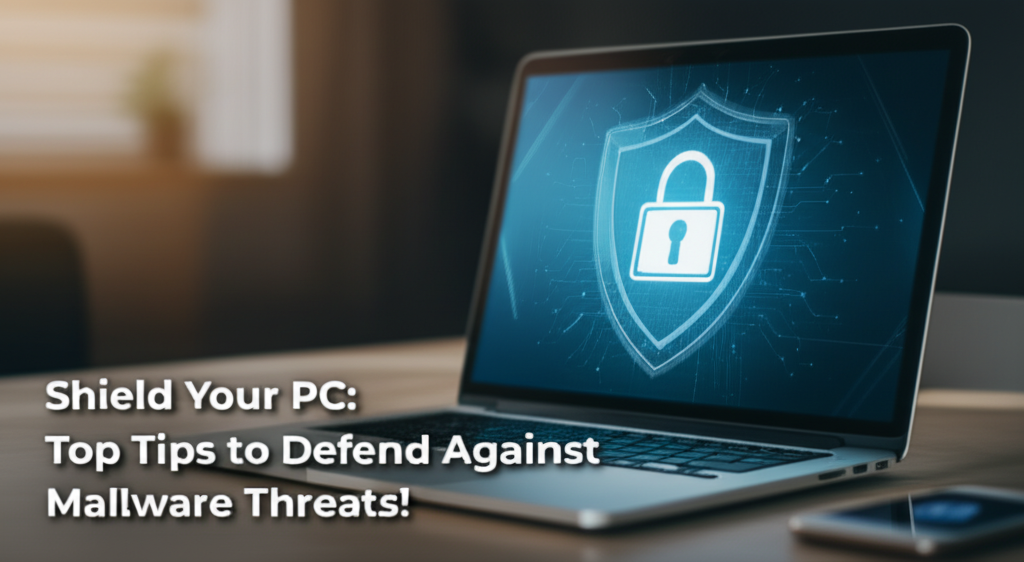Introduction
In today’s digital age, our reliance on computers and the internet has never been higher. From online shopping to banking and social media, our lives are intertwined with technology. However, this convenience comes at a cost: the rising threat of malware. Malware refers to any software intentionally designed to cause damage to a computer, server, or network. Whether it be viruses, ransomware, spyware, or adware, the consequences can be devastating.
Many users face significant challenges in protecting their systems against these threats. The good news is that by following a step-by-step approach, you can effectively shield your computer from malware. This guide will provide you with practical tips, tools, and methods to enhance your PC’s security, ensuring a safer online experience.
Step 1: Understand What Malware Is
What is Malware?
Malware encompasses various malicious software types, including:
- Viruses: Attach themselves to legitimate files and programs.
- Worms: Spread across networks without human intervention.
- Trojan Horses: Disguise themselves as legitimate software.
- Ransomware: Lock your files and demand payment for access.
- Spyware: Secretly monitors your activities and collects information without consent.
Why It’s Important to Know?
Understanding what malware is and how it operates is the first step in protecting your system. Knowledge enables you to recognize potential threats and safeguard your PC effectively.
Step 2: Keep Your Operating System Updated
Keeping your operating system (OS) updated is one of the easiest ways to enhance your defenses.
How to Check for Updates
-
Windows Users:
- Press
Windows + Ito open Settings. - Click on Update & Security.
- Select Windows Update and click Check for updates.
- Press
-
Mac Users:
- Click on the Apple icon in the top left corner.
- Select System Preferences and click on Software Update.
Common Mistake: Ignoring update notifications. Always aim to install updates promptly.
Step 3: Install Antivirus Software
Antivirus software acts as a shield against malware, detecting and removing threats before they can cause harm.
How to Choose and Install Antivirus Software
- Choose Reputable Software: Look for widely recognized names like Norton, McAfee, or Bitdefender.
-
Installation:
- Download the software from the official website.
- Run the installer and follow the on-screen instructions.
- Once installed, run the first scan to check for existing threats.
Alternative Methods: Consider free options like Avast or AVG if you’re on a budget, but always check for real-time protection features.
Step 4: Enable a Firewall
A firewall monitors incoming and outgoing network traffic and can block potential threats.
How to Enable Your Firewall
-
Windows Users:
- Press
Windows + Ito open Settings. - Click on Update & Security -> Windows Security.
- Select Firewall & network protection.
- Ensure that the firewall is turned on for all network profiles.
- Press
-
Mac Users:
- Go to System Preferences -> Security & Privacy.
- Click on the Firewall tab and turn it on.
Common Mistake: Disabling the firewall for troubleshooting without turning it back on later.
Step 5: Use Strong Passwords
Weak passwords can be a gateway for malware.
How to Create Strong Passwords
-
Characteristics of Strong Passwords:
- At least 12 characters long.
- A mix of upper and lowercase letters, numbers, and symbols.
- Avoid common words or easily guessable information.
-
Use a Password Manager: Tools like LastPass or 1Password can help you generate and store complex passwords.
Common Mistake: Reusing passwords across different accounts. Always create unique passwords for each account.
Step 6: Be Cautious with Email and Links
Mail and online communications are common vectors for malware distribution.
Tips to Avoid Malware in Emails
- Don’t Open Suspicious Emails: If you receive an email from an unknown source, don’t open it.
- Hover Over Links: Before clicking on any link, hover over it to see the URL. If it looks suspicious, don’t click!
-
Enable Spam Filters: Most email services have settings to filter out spam and malicious emails.
Common Mistake: Clicking on links without verifying the sender or the URL.
Step 7: Regular Backups
Backing up your data protects you from data loss due to malware attacks like ransomware.
How to Back Up Your Data
-
Use an External Hard Drive:
- Connect the drive to your computer.
- On Windows, use the Backup and Restore feature in Control Panel.
- On Mac, use Time Machine.
- Cloud Storage Solutions: Services like Google Drive or Dropbox allow you to store files online securely.
Common Mistake: Not setting up regular backups. Schedule them weekly or monthly to ensure you always have a recent copy of your data.
Step 8: Educate Yourself on Safe Browsing Habits
Being aware of online threats can significantly reduce your risk of infection.
Safe Browsing Tips
- Stick to Secure Websites: Look for URLs that begin with
https://. - Avoid Downloading Unknown Software: Only download applications from trusted sources.
-
Be Wary of Public Wi-Fi: Avoid connecting to unsecured networks.
Common Mistake: Believing that malware only comes from obvious sources, missing out on second-hand or less-obvious channels.
Step 9: Use Ad Blockers
Ad blockers can prevent malicious ads that may contain malware.
How to Install an Ad Blocker
- Choose a Browser Extension: Popular options include uBlock Origin and AdBlock Plus.
-
Installation:
- Go to your browser’s extension store.
- Search for the ad blocker of your choice and click Add to browser.
Alternative Method: Use browsers with built-in ad blocking features, such as Brave.
Step 10: Regularly Scan for Malware
Even with precautions, vulnerabilities can arise; regular scanning ensures your system remains secure.
How to Run a Malware Scan
-
Using Your Antivirus:
- Open your antivirus software.
- Look for the option labeled Full Scan or Custom Scan.
- Follow the prompts to start the scan.
- Use Malware Removal Tools: Consider additional tools like Malwarebytes for a second opinion on threats.
Common Mistake: Running scans infrequently. Schedule scans weekly for comprehensive protection.
Final Checklist: Confirm Your Protection
Before you conclude your malware defense setup, run through this checklist to ensure you’re fully protected:
- [ ] My OS is updated.
- [ ] Antivirus software is installed and running.
- [ ] My firewall is enabled.
- [ ] I use strong, unique passwords for all accounts.
- [ ] I am cautious with emails and links.
- [ ] My data is backed up regularly.
- [ ] I practice safe browsing habits.
- [ ] An ad blocker is installed.
- [ ] I regularly scan for malware.
Conclusion
By following these steps, you significantly increase your PC’s defenses against malware threats. Remember, security is an ongoing process. Regularly revisit and update your strategies, and stay informed about the latest threats. With a proactive approach, you can enjoy a safer digital experience!
For a comprehensive and secure computing journey, engage in good digital hygiene, be aware of potential risks, and utilize the tools available to you. Your computer will thank you!

